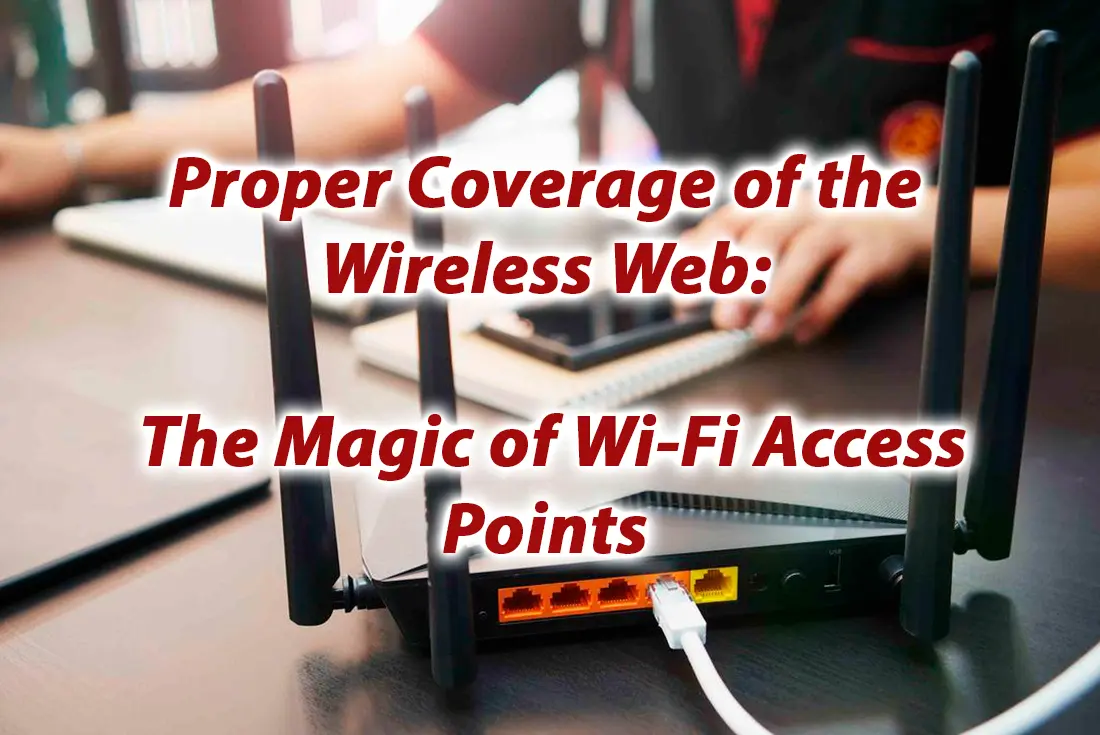
17 Nov Proper Coverage of the Wireless Web: The Magic of Wi-Fi Access Points
Wireless access points, or WAPs for short, act as bridges. They link our laptops, smartphones, and other wireless gadgets to the internet. They also extend the reach of wired networks so we can move around freely without losing our connection.
The internet has changed a lot from the old days of wired connections. Wi-Fi and WAPs have made the internet faster, better, and easier. They also helped start new tech like the Internet of Things (IoT), which connects everyday items to the internet. So, let’s take a moment to appreciate the magic of WAPs.
Understanding Wi-Fi Access Points
Now, let’s see what exactly these devices are and what they do.
What Are Wi-Fi Access Points?
WAPs connect other Wi-Fi-enabled devices to a network that’s wired. They can be separate devices or part of other networking hardware like routers. This lets you use the internet without physically connecting to the network.
Different Types of Wi-Fi Access Points
There are many types of Wi-Fi points. Wireless routers bring internet into your home and give you Wi-Fi. Wi-Fi extenders make the Wi-Fi signal stronger and spread it further. Mesh network nodes are used in big networks to keep Wi-Fi smooth and direct traffic well.
Functions and Features of Wi-Fi Access Points
WAPs help make internet connections safe and dependable. They do this by making your wired network reach further and letting many devices connect simultaneously. They protect data with things like WPA3 encryption. Some even allow you to choose which devices get more internet speed, making everything run smoothly.
How Wi-Fi Access Points Work
Let’s explore the technical side of WPAs and look at their roles:
Technical Aspects of Wi-Fi Access Points
A wireless network adapter is at the core of a Wi-Fi access point (WAP). This adapter changes an incoming internet signal from a wired source (like an Ethernet cable) into a radio signal. This radio signal is then sent out through an antenna.
The WAP operates on certain frequencies — usually 2.4 GHz or 5 GHz. The 2.4 GHz frequency offers wider coverage but slower speeds, while the 5 GHz frequency gives faster speeds but over a smaller distance.
Transmission and Reception of Wireless Signals
A Wi-Fi access point (WAP) sends out a radio signal. Devices in range can connect to it. Your device changes data into a radio signal and sends it to the WAP. The WAP turns this signal into internet data and sends it to the network. When the network answers, the WAP returns a radio signal to your device. Your device gets this signal, changes it back into data, and shows you the web page or video you asked for.
Role of Wi-Fi Access Points in Providing Internet Connectivity
A Wi-Fi access point’s job is to give internet access to wireless devices. It works like a bridge between the wired network and our gadgets. Modern ones can handle many devices at once, sharing the total internet speed among these devices. This is very helpful in places with many devices, like homes or offices, ensuring everyone can use the internet.
Need help with setting up your home wireless network? At Downtown Computer Services, we are ready to get your network up and running smoothly.
Call us now at: (954) 524 9002
Benefits of Wi-Fi Access Points
WAPs boost Wi-Fi signals, so they’re great for big areas where one router falls short. You can put a WAP anywhere with power and a network cable. Some can use the same cable for both. WAPs let many devices connect at once. They manage internet speed for each device and can give more speed to certain ones if needed.
Choosing the Right Wi-Fi Access Points
It’s time to figure out how to pick a WPA that will suit your needs:
Factors to Consider When Selecting Wi-Fi Access Points
When picking a WAP, think about your area, how many devices you have, and how you use the internet. A single router could work for a small flat, but bigger spaces might need extra extenders or mesh networks. For many devices or heavy streaming/gaming, go for a quick, Wi-Fi 6-compatible WAP. Remember to look for strong security features like WPA3 support.
Comparing Different Wi-Fi Access Point Options
WAPs are of different kinds. Routers give internet but can have trouble with big spaces or blocks. Extenders make the router’s signal stronger to reach far places, but they can slow down Wi-Fi and may need you to switch networks by hand. Mesh Networks use many devices to make a smooth Wi-Fi network for large areas without slowing down the internet; they can cost more and be trickier to set up.
Best Practices for Optimizing Wireless Access Coverage
These tips will help you get the most out of Wi-Fi access points:
Smart Placement: Put your WAPs in the middle of the area, not in corners, to spread the Wi-Fi better. And remember, Wi-Fi can struggle with certain materials, so don’t put your WAPs behind thick walls or metal things.
Pick the Best Frequency: Use the 5 GHz frequency for gadgets that need fast Wi-Fi and are near the WAP. Use the 2.4 GHz frequency for devices that are further away or don’t need super-fast speeds.
Keep Firmware Up to Date: Firmware updates that can make WAPs work better and be safer. Make sure your WAPs always have the latest firmware.
Troubleshooting Wi-Fi Access Points
WAPs can sometimes have problems. But fear not; we’ll help you deal with them. Keep reading!
Common Issues with Wi-Fi Access Points and Their Solutions
If something doesn’t work as you want, it’s not the reason to panic.
Can’t Connect: First, make sure the WAP is on and properly connected to your router or modem. If that all looks good, but it’s still not working, try resetting the WAP to its original settings and setting it up again.
Slow Speed: Try getting closer to the WAP with your device. If that doesn’t help, too much traffic might be on your network. Try changing the Wi-Fi channel or frequency band on your WAP.
Connection Drops: It might be because of interference from other electronics. Try moving your WAP away from microwaves, cordless phones, and baby monitors that use the same frequency as your WAP.
Dealing with Connectivity Problems and Interference
Interference from other electronic devices or Wi-Fi networks is a common cause of connectivity problems. Here’s how to reduce interference:
Switch Your Channel: Many WAPs automatically choose a channel to broadcast on. But if this channel is busy with other networks, it can create issues. Try picking a different channel manually in your WAP’s settings.
Use the 5 GHz Band: Consider switching to the 5 GHz band if your WAP allows it. It’s less prone to interference as fewer gadgets use it.
Proper WAP Placement: Position your WAP in an open, central spot in your home. Avoid putting it near walls or large metal items that can block or bounce off Wi-Fi signals.
Tips for Maintaining and Upgrading Wi-Fi Access Points
Keep your WAPs working well by often updating them using their app or website. Use a strong password and WPA2 or WPA3 for safety. Make your Wi-Fi cover more area and be faster by putting your WAPs in good spots, moving antennas, and adding more devices if needed. Replace old WAPs and pick ones that use new Wi-Fi, like Wi-Fi 6, for quicker internet.
Future Trends in Wi-Fi Access Points
Tech is advancing fast, and so are WAPs. With new technologies and the impact of Wi-Fi 6, the future of wireless internet is thrilling.
Emerging Technologies and Advancements in Wireless Access Points
AI can make our networks better and safer, helping Wi-Fi change channels when there’s a lot of traffic. As more things connect to the internet, future Wi-Fi spots will be designed to handle more connections. With new 5G technology, Wi-Fi can be used for faster speeds and less waiting time.
The Potential Impact of Wi-Fi 6 on Connectivity and Performance
Wi-Fi 6, or 802.11ax, is the latest version, offering speeds up to 9.6 Gbps, nearly thrice as fast as Wi-Fi 5. Its feature, OFDMA, allows handling multiple devices simultaneously, providing smooth operation even in crowded places like airports or stadiums.
Predictions for the Future of the Wireless Web and Wi-Fi Access Points
As people use the internet more for things like 4K videos, WAPs must be faster and offer more data. AI and Machine Learning will help networks work better and stay safe. New tech like mesh networks and Wi-Fi 6 will let people stay online without any breaks or places with no signal.
Conclusion
WAPs, like basic routers and advanced networks, help us go online. They’re getting quicker and safer with new tech like Wi-Fi 6, AI, and IoT. As we need more speed and as tech like 5G and IoT grows, WAPs will get better. These unseen helpers connect us to the world and make information easy to reach. As digital tech keeps changing, so will these internet gateways.
Looking to improve your home wireless network? Call Downtown Computer Services at (954) 524 9002 and let us help you stay up to date!
Check out other relevant news
- How Easy-to-Use Hacking Tools Are Fueling Cybercrime
- Cryptocurrency Security for Small Businesses: Protecting Your Wallet
- The Infostealer Epidemic: Protecting Your Business from the Latest Wave of Cyberattacks
- The Identity Crisis: How Compromised Credentials Can Cripple Your Business
- Beyond the Brick and Mortar: Building Your Online Storefront with Digital Marketing
